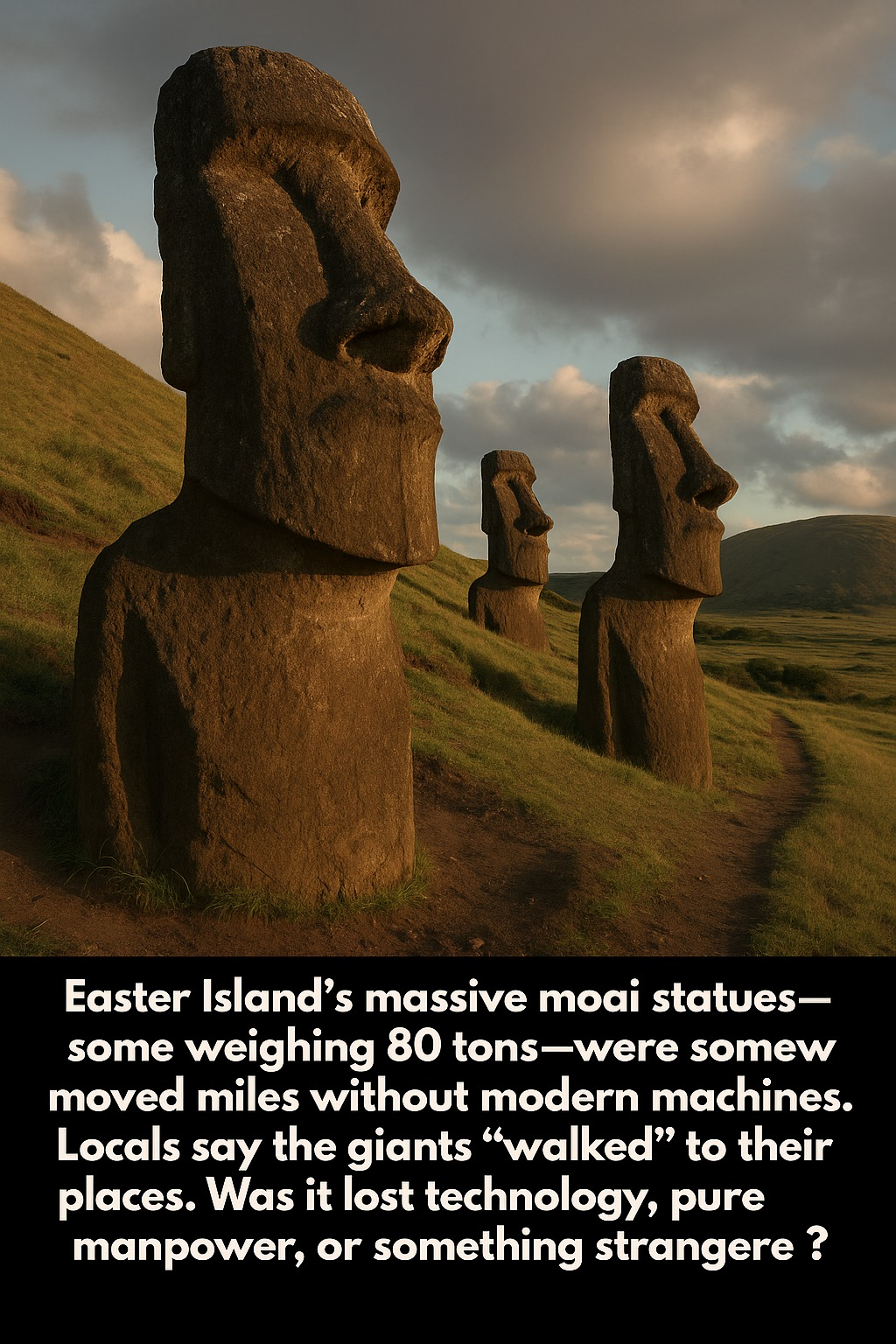
Far out in the endless blue expanse of the Pacific Ocean lies a speck of land—rugged, windswept, and steeped in secrets. It is called Rapa Nui, but to the world, it is known as Easter Island. Few places on Earth possess the same haunting gravity as this isolated volcanic rock, where nearly 900 monolithic statues—called moai—stand sentinel across the hills, their backs to the sea, gazing inward as if watching over a vanished people.
Each moai is a marvel of stone and silence: towering between 3 to over 10 meters high, some weighing more than 80 tons. Carved from compressed volcanic ash known as tuff, these statues were born from the Rano Raraku quarry, where half-finished figures still lie in place, frozen in time like abandoned dreams. What drove the ancient Rapa Nui to sculpt such colossal beings, and more baffling—how did they move them miles across the unforgiving terrain without wheels, steel, or modern machinery?
It is a riddle that has intrigued explorers, archaeologists, and dreamers for centuries.
A Kingdom of Stone and Spirit
Long before the first European sails breached the horizon in 1722, the Rapa Nui people had already shaped their landscape into a sprawling shrine. Their ancestors likely arrived by canoe around 1200 CE, navigating thousands of kilometers using only the stars, wind, and waves. What they found was a remote island rich in fertile soil, thick forests, and seabirds that blanketed the sky.
From this abundance emerged a deeply spiritual and organized society. The moai, scholars believe, were carved in honor of ancestral chiefs, intended to project power and preserve their mana—a sacred spiritual force. These statues weren’t merely art; they were vessels of memory and reverence, each one inscribed with the idenтιтy and authority of a long-departed soul.
But while their meaning hints at sacred continuity, their movement tells a story of Herculean endeavor.
The Enigma of Motion
How did a pre-industrial society transport statues taller than two-story buildings, sometimes over 10 miles across the island’s jagged landscape?
For years, theories collided. Some proposed sledges and log rollers—an idea consistent with Polynesian ingenuity. Others imagined enormous manpower pulling the statues upright with ropes, like dragging a stubborn god through the dirt. Then came the startling accounts from Rapa Nui elders who insisted the statues had not been dragged at all—they had walked.
Walked?
The term seemed poetic, absurd even, until archaeologists Terry Hunt and Carl Lipo took it seriously. In 2012, using ropes and a trio of teams, they demonstrated that by tilting a replica moai side to side, while pulling forward in a rocking motion, the statue could indeed “walk.” The rhythm, balance, and collaboration needed for this feat reflected not just clever engineering but a deep cultural choreography, perhaps pᴀssed down orally for centuries.
Could it be that this method—the sway of stone, the chant of rope—was how the giants truly moved?
Collapse and Questions
But the story of the moai is not only one of creation—it is one of collapse.
By the time European ships arrived, the once-forested island was barren, and the moai had toppled. The Rapa Nui population had plummeted. Oral traditions spoke of civil war, famine, and the end of the old ways. Scholars speculated that ecological disaster—perhaps caused by overharvesting trees for moai transport—led to societal implosion. Others argued for a more complex narrative, one that included colonial disruption, slavery, and introduced diseases that devastated the population.
Still, the moai remained. Some broken, some buried, others standing defiantly against the wind, their stone faces etched with weariness and wisdom.
In recent decades, archaeologists have uncovered that many moai have full torsos beneath the earth—buried not just by time, but perhaps purposefully. Carvings on their backs, once thought plain, revealed intricate tattoos and inscriptions. Each discovery layers more complexity onto an already intricate puzzle.
The Eyes That See
One moai was found with its eye sockets inlaid with white coral and red scoria pupils—a detail that transformed the statue from monument to living ancestor. When the eyes were added, it is said, the moai could see. They could guard. They could judge.
This moment—the moment the eyes were placed—was likely ceremonial, transcendent. It marked the statue’s awakening, its becoming. To walk among these тιтans today, even without the eyes restored, is to feel their watchfulness. They do not speak, but their silence hums with gravity.
One cannot help but wonder: Were they built to connect heaven and earth? To channel power? Or were they merely the final, desperate grasp of a people seeking permanence in the face of impermanence?
Echoes in Stone
Rapa Nui teaches us not just about stonework and survival, but about human longing. The moai are love letters to ancestry, warnings of fragility, and proof of brilliance.
They whisper of a time when humanity, isolated on a speck of land in a vast ocean, chose to dream big—to carve immortality into rock.
And perhaps, they ask us today: What will we leave behind? What giants will we build—not in size, but in spirit? And will they walk too, long after we are gone?
#MoaiMystery
#EasterIslandEnigma
#AncientEngineering
#LostCivilizations
#RapaNuiWisdom
#WalkingGiants
#ArchaeologicalWonder
#SacredStone
#MysteriesOfThePast
#TheIslandThatSpeaks


